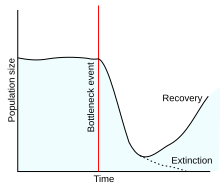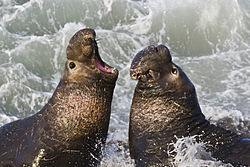Population bottleneck

A population bottleneck or genetic bottleneck is a sharp reduction in the size of a
The genetic drift caused by a population bottleneck can change the proportional random distribution of alleles and even lead to loss of alleles. The chances of inbreeding and genetic homogeneity can increase, possibly leading to inbreeding depression. Smaller population size can also cause deleterious mutations to accumulate.[3]
Population bottlenecks play an important role in conservation biology (see minimum viable population size) and in the context of agriculture (biological and pest control).[4]
Minimum viable population size
In conservation biology, minimum viable population (MVP) size helps to determine the effective population size when a population is at risk for extinction.[5][6] The effects of a population bottleneck often depend on the number of individuals remaining after the bottleneck and how that compares to the minimum viable population size.
Founder effects
A slightly different form of bottleneck can occur if a small group becomes reproductively (e.g., geographically) separated from the main population, such as through a founder event, e.g., if a few members of a species successfully colonize a new isolated island, or from small captive breeding programs such as animals at a zoo. Alternatively, invasive species can undergo population bottlenecks through founder events when introduced into their invaded range.[7]
Examples
Humans
According to a 1999 model, a severe population bottleneck, or more specifically a full-fledged
A 2005 study from Rutgers University theorized that the
The Neolithic Y-chromosome bottleneck refers to a period around 5000 BC where the diversity in the male y-chromosome dropped precipitously, to a level equivalent to reproduction occurring with a ratio between men and women of 1:17.[12] Discovered in 2015[13] the research suggests that the reason for the bottleneck was not a reduction in the number of males, but a drastic decrease in the percentage of males with reproductive success.
Toba catastrophe theory
The controversial Toba catastrophe theory, presented in the late 1990s to early 2000s, suggested that a bottleneck of the human population occurred approximately 75,000 years ago, proposing that the human population was reduced to perhaps 10,000–30,000 individuals[14] when the Toba supervolcano in Indonesia erupted and triggered a major environmental change. Parallel bottlenecks were proposed to exist among chimpanzees, gorillas, rhesus macaques, orangutans and tigers.[15] The hypothesis was based on geological evidence of sudden climate change and on coalescence evidence of some genes (including mitochondrial DNA, Y-chromosome DNA and some nuclear genes)[16] and the relatively low level of genetic variation in humans.[14]
However, subsequent research, especially in the 2010s, appeared to refute both the climate argument and the genetic argument. Recent research shows the extent of climate change was much smaller than believed by proponents of the theory.[17]
In 2000, a Molecular Biology and Evolution paper suggested a transplanting model or a 'long bottleneck' to account for the limited genetic variation, rather than a catastrophic environmental change.[8] This would be consistent with suggestions that in sub-Saharan Africa numbers could have dropped at times as low as 2,000, for perhaps as long as 100,000 years, before numbers began to expand again in the Late Stone Age.[18]
Other animals
| Year | American bison (est) |
|---|---|
| Before 1492 | 60,000,000 |
| 1890 | 750 |
| 2000 | 360,000 |
European bison, also called wisent (Bison bonasus), faced extinction in the early 20th century. The animals living today are all descended from 12 individuals and they have extremely low genetic variation, which may be beginning to affect the reproductive ability of bulls.[19]
The population of American bison (Bison bison) fell due to overhunting, nearly leading to extinction around the year 1890, though it has since begun to recover (see table).

A classic example of a population bottleneck is that of the northern elephant seal, whose population fell to about 30 in the 1890s. Although it now numbers in the hundreds of thousands, the potential for bottlenecks within colonies remains. Dominant bulls are able to mate with the largest number of females—sometimes as many as 100. With so much of a colony's offspring descended from just one dominant male, genetic diversity is limited, making the species more vulnerable to diseases and genetic mutations.
The
An extreme example of a population bottleneck is the New Zealand black robin, of which every specimen today is a descendant of a single female, called Old Blue. The Black Robin population is still recovering from its low point of only five individuals in 1980.
The genome of the giant panda shows evidence of a severe bottleneck about 43,000 years ago.[20] There is also evidence of at least one primate species, the golden snub-nosed monkey, that also suffered from a bottleneck around this time. An unknown environmental event is suspected to have caused the bottlenecks observed in both of these species. The bottlenecks likely caused the low genetic diversity observed in both species.
Other facts can sometimes be inferred from an observed population bottleneck. Among the Galápagos Islands giant tortoises—themselves a prime example of a bottleneck—the comparatively large population on the slopes of the Alcedo volcano is significantly less diverse than four other tortoise populations on the same island. DNA analyses date the bottleneck to around 88,000 years before present (YBP).[21] About 100,000 YBP the volcano erupted violently, deeply burying much of the tortoise habitat in pumice and ash.
Another example can be seen in the
Population bottlenecking poses a major threat to the stability of species populations as well. Papilio homerus is the largest butterfly in the Americas and is endangered according to the IUCN. The disappearance of a central population poses a major threat of population bottleneck. The remaining two populations are now geographically isolated and the populations face an unstable future with limited remaining opportunity for gene flow.[23]
Genetic bottlenecks exist in cheetahs.[24][25]
Selective breeding
Bottlenecks also exist among pure-bred animals (e.g.,
Selective breeding to produce high-yielding crops has caused genetic bottlenecks in these crops and has led to genetic homogeneity.[28] This reduced genetic diversity in many crops could lead to broader susceptibility to new diseases or pests, which threatens global food security.[29]
Plants
Research showed that there is incredibly low, nearly undetectable amounts of genetic diversity in the genome of the Wollemi pine (Wollemia nobilis).[30] The IUCN found a population count of 80 mature individuals and about 300 seedlings and juveniles in 2011, and previously, the Wollemi pine had fewer than 50 individuals in the wild.[31] The low population size and low genetic diversity indicates that the Wollemi pine went through a severe population bottleneck.
A population bottleneck was created in the 1970s through the conservation efforts of the endangered Mauna Kea silversword (Argyroxiphium sandwicense ssp. sandwicense).[32] The small natural population of silversword was augmented through the 1970s with outplanted individuals. All of the outplanted silversword plants were found to be first or subsequent generation offspring of just two maternal founders. The low amount of polymorphic loci in the outplanted individuals led to the population bottleneck, causing the loss of the marker allele at eight of the loci.
See also
- Baby boom
- Population boom
References
- ]
- PMID 3420403.
- S2CID 14762497.
- S2CID 45796650.
- ISBN 978-0-87893-794-3.
- ISBN 978-0-521-33657-4.[page needed]
- ^ Lee, C. E. (2002). Evolutionary genetics of invasive species. Trends in ecology & evolution, 17(8), 386-391.
- ^ PMID 10666702.
- ^ Zimmer, Carl (31 August 2023). "Humanity's Ancestors Nearly Died Out, Genetic Study Suggests - The population crashed following climate change about 930,000 years ago, scientists concluded. Other experts aren't convinced by the analysis". the New York Times. Archived from the original on 31 August 2023. Retrieved 2 September 2023.
- from the original on 1 September 2023. Retrieved 2 September 2023.
- ^ "North America Settled by Just 70 People, Study Concludes". LiveScience. 2005-05-25. Retrieved 2010-04-01.
- ^ Starr, Michelle (31 May 2018). "Something Weird Happened to Men 7,000 Years Ago, And We Finally Know Why". sciencealert.com. Retrieved 12 September 2023.
- PMID 25770088.
- ^ ISBN 0-297-82503-8.
- ISBN 9780253010360.
- S2CID 33122717.
- ^ "Doubt over 'volcanic winter' after Toba super-eruption. 2013". Phys.org. 2013-05-02. Retrieved 2015-10-31.
- PMID 18439549.
- Paul Rincon (April 24, 2008). "Human line 'nearly split in two'". BBC News.
- S2CID 34102378.
- S2CID 13945117.
- S2CID 39102858.
- ^ PMID 28386428.
- PMID 28698508.
- PMID 8475057.
- PMID 2983425. Archived from the original(PDF) on 2006-05-07.
- ^ PMID 16341006.
- PMID 26699508.
- ^ National Research Council. (1972). Genetic vulnerability of major crops. National Academies.
- PMID 17068128.
- S2CID 35255532.
- .
- S2CID 83819334.
External links
- Hawks J, Hunley K, Lee SH, Wolpoff M (January 2000). "Population bottlenecks and Pleistocene human evolution". Molecular Biology and Evolution. 17 (1): 2–22. PMID 10666702.
- "New study suggests big bang theory of human evolution". University of Michigan, Department of Anthropology (Press release). January 10, 2000. Archived from the original on February 5, 2014. Retrieved March 4, 2014.
- Northern Elephant Seal History
- Nei M (May 2005). "Bottlenecks, genetic polymorphism and speciation". Genetics. 170 (1): 1–4. PMID 15914771.
